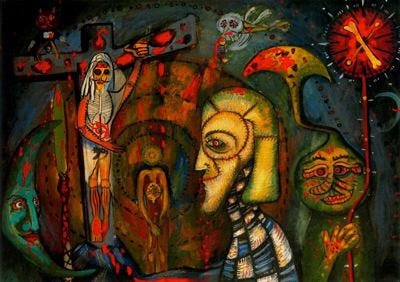Seven Sided Dice
Dau Al Set--Persistent Creation
Dau Al Set (seven sided dice) was an association of Spanish artists founded in Barcelona in 1948 and active until 1953; they published a periodical with the same name. They worked with abstractions but were not modernists. Instead they pursued the perennialist vision of bringing the uncreated into focus, a very important distinction from narcissistic modernism. The most significant members were the symbolist philosopher and art critic J. Eduardo Cirlot, poet Arnoldo Puig, and four painters— Modesto Cuixart, Joan Ponç, Antoni Tàpies, and Joan José Tharrats.
Although the relationship between Dau Al Set and the often vilified Francisco Franco administration (1939-1975) was at times fractious yet somehow these creative philosophers and artists found a way to co-exist when many others left for exile in France. At times General Franco even praised the work of this group proclaiming Modesto Cuixart, “...our new Goya” while other times the government criticized them.
Perhaps by keeping a calculated distance from these avant-garde artists Franco allowed them to grow and come into their own. A perverse but effective relationship. Caught between an authoritarian regime and a stifling Roman Catholic heritage Cuixart fashioned himself as a spiritual “anarchist” in the Catalonian secessionist tradition of anti-establishment movements.
The philosopher and poet Juan Eduardo Cirlot wrote an important book on symbols during this period. A Dictionary of Symbols is still in print and remains a popular resource. In 1962 reviewer, Barbara A. Chellis, called the book "…a momentous contribution to symbology".1
Another notable artist who was nurtured by Dau Al Set was the psycho-spiritual expressionist Joan Ponç Bonet, (d.1984). His lively paintings often featured apocalyptic themes embedded with metaphysical symbolism. A far cry from the atheism of earlier modernists. He once described his artistic life, “I am a brother who has visited a magical place called creation.”
Not unlike the rise of the Eastern European artists who came into prominence in the generation before WWI in that these artists and writers were nurtured in an environment that would be considered stifling in the American context today. Yet they were able to make a strong contribution to Western culture without playing a victim card.
View the entire website HERE
You can purchase my book CLICK HERE





Very interesting read. You use different modes of reaching the senses of the reader. You address the spiritual simultaneously on different levels. Those with ears will hear, those with eyes will see, .... Good post.